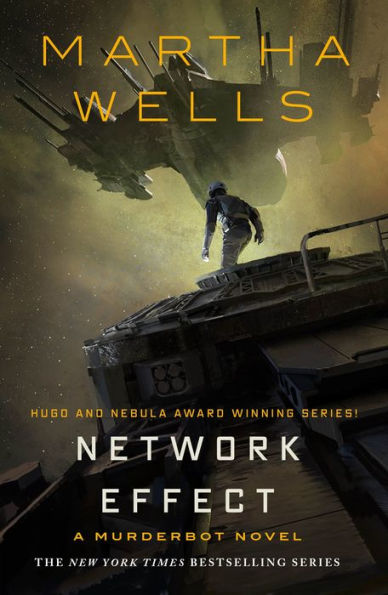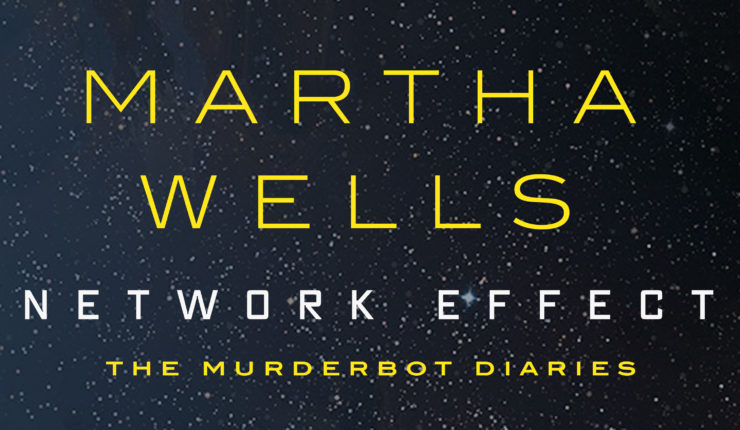Look: to know Murderbot is to love Murderbot (that goes for the character as well as their titular series). It’s not just that Murderbot is relatable (though they somehow are) or that I want to protect them like a murderous, sweet summer child (though god help me, I do). Loving Murderbot is just a natural outgrowth of witnessing them, page after page, do so much good and act—in spite of themselves—out of such depth of feeling. The series is a redemption narrative and a coming-of-age plot wrapped up in a space opera—a story about the stories we tell so often they grow into something new. Network Effect, the series’ first full-length novel, is no exception.
Between 2017 and 2018, Martha Wells gifted us almost 1.5 glorious years of social awkwardness, dry wit, and proficiency porn. Following up that quartet—All Systems Red (May 2017), Artificial Condition (May 2018), Rogue Protocol (August 2018), and Exit Strategy (October 2018)—Network Effect follows Murderbot on a whole new adventure with a familiar cast of characters. Murderbot is on a mission, this time, with a team—their team. And not just as a security detail, but as a friend. Figuring out what friendship is and means is tricky, though, especially when you throw hivemind alien tech and corrupt corporations into the mix.
Note: a major spoiler for the first ~150 pages of Network Effect ahead.
My expectations for a Murderbot sequel were as follows: I expected to learn more about the corporations, including “the company;” to perhaps witness some kind of rebellion or other political upheaval; to explore in more depth the personhood of bots and constructs and to see some kind of understanding reached by Murderbot (for sexbots, especially!); and of course, more media consumption, more space fights, and more ruminations on autonomy and community.
Buy the Book


Network Effect
The reality of reading Network Effect was like settling into a warm bath. Don’t get me wrong—the novel includes plenty of action and tension and forward momentum. The main plotline follows Murderbot as they attempt to rescue their crew and literally turn themselves into malware, and you really can’t get more action-packed than that. But I’d apparently forgotten to anticipate the sheer pleasure that comes from reading Martha Wells’ storytelling. A lot of my expectations were met, but still more were exceeded. For instance, I didn’t even dare to hope that the series would get queerer, but I’m happy to report that Wells’ imagination is not nearly as limited by cynicism as my own. I may have anticipated growth in Murderbot’s relationship with their human crew and with other bots, but the return of ART was maybe the best thing about 2020 so far.
The return of the series’ exploration of media was immensely satisfying as well. First of all, I’ll never tire of its meta-commentary: if the first four novellas mimic Murderbot’s favorite episodic serials, Network Effect packs the punch of a full-length film (or, as the theatre festival at the start of the novel implies, a play). But the stories’ genres/forms don’t stand alone in their commentary on how media shapes our lives and personal stories. So much is communicated in the moments where characters talk about theatre or space TV, and even more when ART and Murderbot watch serials together. These moments are like little pockets of peace in the midst of chaos, the stuff—as much as major events and plot points—that life is made of. They speak not only to shared narratives, but also the ways that we learn to be better and, well, fake it till we make it. Most fiction would be utterly cynical when tackling such a theme (you can imagine the Black Mirror episode now), but I don’t think there’s a cynical page in this book. Media doesn’t exist in Murderbot’s world as mind control or even as mere distraction, but as meaning maker, community builder, and respite from pain and violence.
Another return to form in Network Effect is Wells’ deft exploration of the line between the corporeal and non-corporeal forms. As in the previous books, the actual plot hinges on the non-literal, with cognitive and technical experiences rather than physical ones driving the emotion and drama of the story. New (or at least deepened) in Network Effect is the exploration of trauma—both Murderbot and Mensah’s—and how it is literally written on or in the body. ART and Murderbot’s developing relationship adds an additional layer to this embodiment, with Wells portraying a quasi-romantic relationship totally outside of the body, taking away things like eye contact and gesture. Their relationship is instead built on the language of story and shared experience.
(There’s something to be said, regarding this non-embodied love, for ace and neurodivergent representation in the series, though I wouldn’t want to belabor the allegory [no, asexual people aren’t all robots—you know what? We don’t have to go there]. The fact that so many identities are mappable onto Murderbot is—unsurprisingly—just another beautiful, glorious thing about media as a meaning-making machine.)
For all the ways that Network Effect builds on the previous books and answers their questions, the series does not feel over. More threads may have been stitched together, but the complete quilt hasn’t been revealed yet. We have Murderbot’s relationships with individual bots and constructs (boy, do we), but not with, like, botdom as a whole (what’s the robot version of class consciousness?). We have stacks and stacks of company crimes and even an introduction to an anti-establishment group, but still no direct confrontation of the system itself. Look all I’m saying is I want a Murderbot revolution (even though I know they’d hate that. Sorry, Murderbot!). But until I get one, I will—true to form—just keep rereading the old serials and delighting in their every twist and turn.
Network Effect is available from Tor.com Publishing.
Em Nordling reads, writes, and manages research in Louisville, KY.











I’m yawning my way through Zoom meetings today, having devoured Network Effect as soon as it dropped on my Kindle. LOVE IT!!! (I really hope “the feed” isn’t like having Zoom in your head)
Perhaps the next book will bring Tapan and family back- someone who can identify alien remnants might come in handy in the further adventures.
I remain blackly amused that Murderbot would probably be horrified by my/our fondness for it. Such emotional attachments would only make it harder for it to do its job and it already has enough humans being weirdly concerned for its well-being.
Given that I’m just finishing yet another listen to The Goblin Emperor, I’m surprised at how similar they are in emotional content, despite Murderbot’s occasional interludes of mayhem. Maia is constrained mostly to stay in one place and have things done for him, Murderbot is almost defined by its ability to go places and do things for itself. Yet both books have a strong sense of confusion and uncertainty seeking resolution while being driven largely by a concern for others, even if unexpected by everyone else.
My favourite line:
“You are incorrect, Iris, I can bomb the colony”
Murderbot’s pronouns are it/its, not they/them.